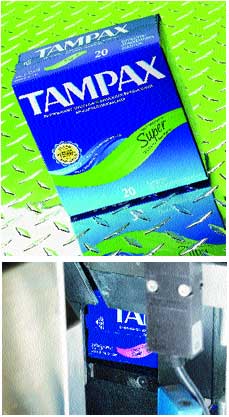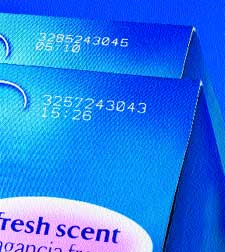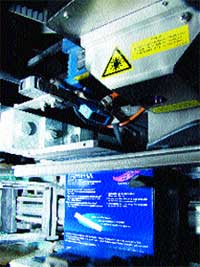Laser coding suits Procter & Gamble's Tambrands just fine
January 29, 2014
|
As traceability of personal care products became more important for manufacturers, Tambrands looked at various alternative carton-coding methods, favoring laser coding for its accuracy, reliability and repeatability. |
The installation of steered-beam laser printers for tampon cartons at Procter & Gamble's Tambrands Div. in Auburn, ME, has improved code quality and reliability, reduced downtime and eliminated consumables. Based on the successful trial of the first unit, Videojet's Focus S10 laser-coding system, Tambrands has installed more than 10 additional Focus S10 printers, which are currently in operation at Tambrands' Auburn plant.
P&G has recognized for some time that taking the necessary steps to apply manufacturing origin information on packaging is just the beginning of many changes to come in product coding, anticounterfeiting procedures and other product identification methods. P&G today markets nearly 300 products to more than five billion consumers in 140 countries. Tambrands, a P&G company since 1997 and manufacturer of market-leading Tampax tampons, manufactures its products in five countries.
Replacing a group of debossing wheel coders, the Focus S10 systems code assorted outer cartons of Tampax®, Tampax Pearl, Tampax Satin and Tampax Multipax tampons in counts of 20 or more. P&G says that to date, the Tambrands Div. has experienced no in-line equipment failures related to the laser printers and that the units are actually running better than originally predicted. Using nontoxic inks, the S10s produce significantly higher-quality codes, P&G says.
|
Date/time codes are consistently crisper and more legible, and can be changed each day automatically. |
For any consumer product, but especially for personal care and pharmaceuticals, traceability has become increasingly important in recent years. And for manufacturers like Cincinnati-based P&G, in the unlikely event of a product recall, having the ability to trace the origin of a product is essential, not only to keep questionable products from entering the market, but also to narrow the scope of the recall, so the minimal amount of product is returned, which reduces costs to the manufacturer.
Mounted within the individual production line cartoners (Tambrands uses cartoning equipment from several vendors, but says the majority are from R.A. Jones), the Focus S10 systems apply a 10-digit, two-line code onto each fiberboard outer carton holding the wrapped tampons (the fiberboard cartons are provided by several sources). The code is comprised of a date code and a time stamp, for product traceability. In fact, Tambrands says every product package the plant produces is coded.
While P&G has been coding its product packaging for many years, Tambrands used manual debossing wheels to stamp code dates into the flaps of the fiberboard cartons. The manual coding method required that manual code changes be made daily, which meant operation on the packaging lines had to be interrupted. The wheel coding method was also vulnerable to variations in carton material thickness and left open the opportunity for human error. Tambrands says it wanted a new system that was more reliable and repeatable.
Laser system won out
Pat O'Brien, technology leader for Tambrands, took on the task of researching and evaluating alternative methods of applying the carton code. O'Brien looked at many types of ink-jet printing and laser-coding equipment on the market, collecting information from the various manufacturers on unit costs, installation costs, equipment capabilities, print quality, maintenance and consumables costs.
O'Brien then sent a carton to each prospective coding equipment vendor, with technical specifications. The vendors returned the packages with the requested information, and O'Brien evaluated each one, based on the parameters. He then developed a technology recommendation using a three-year project life, and concluded that Videojet's Focus S10 laser-coding system met all of the technical specifications and provided the best value with little maintenance.
In selecting a laser system instead of an ink-jet printer, O'Brien notes that the incremental capital of the Focus S10 system was cost-justified, since it had no consumables and was more reliable than the ink-jet printers he evaluated. In addition, the system generates clean, permanent, high-resolution marks and codes, and could be easily installed on most production lines because of its compact footprint.
By O'Brien's estimates, the laser-coding equipment costs nearly half of what it costs to operate many ink-jet systems annually. "When we factored in the consumable costs for ink-jet systems, we found that the lower-priced laser coders represent a better value, once the total ownership costs are considered," he says.
"The improvement we've realized is clearer, more consistent, more reliable codes," O'Brien says. "Laser coders work well with printed fiberboard cartons due to the color contrast of the dark-blue-printed board. The code wheels, which imprinted a code onto one carton flap, didn't work that well. The imprint varied, depending on board thickness and machine speed, and the code had a fixed character size and spacing. The laser code can be easily varied by carton size to produce a smaller code on smaller cartons."
The steered-beam laser-coding system directs a laser beam through a series of vectors in the printhead to create more defined, clearer, more precise alphanumerics than possible with a conventional dot-matrix or other ink-jet printer, according to Videojet. A removable, password-protected, hand-held user interface provides a large keypad and a simple-to-use touchscreen with a what-you-see-is-what-you-get (WYSIWYG) display that can be viewed at different angles. The printer uses air-cooled, carbon dioxide (CO2) technology to provide clean operation without the need for fluids, parts and routine maintenance.
|
Mounted within each cartoning machine, the laser coder generates a two-line production code and time stamp on the cartons as they travel through. |
With the equipment/technology selected, O'Brien says he and his team began to integrate the Focus S10 laser coder into an existing production line. Next, they purchased their first Focus S10 printer and installed it in March of 2002, testing the system for a month to confirm that it would meet P&G's criteria.
The test pointed out any integration issues that could arise, so that actual issues, if any, could be resolved. Once the testing was complete, P&G decided to purchase additional units to be rolled out through the entire facility. The production area where the 10-watt coders were installed is temperature- and humidity-controlled to approximately 70 deg F, with 60-percent RH.
The printers delivered excellent code print contrast for visibility and improved code legibility, though the cartonboard was pretty easy to code using the laser system. The Focus S10 systems also eliminated the daily task of stopping the machine at midnight to change the date code in the debossing wheel, O'Brien says. Now, the code is automatically changed in seconds. "This has eliminated machine stoppages and saves operator effort," O'Brien says. The added production time stamp feature provides more accurate product traceability than could the former debossing wheel coders and enables P&G to reduce scrap in the event of a quality issue. Videojet's Reg LaMere points out that while it's not inspecting the printed message, the laser-coding system, being linked with a PLC, can monitor whether or not the system receives the signal to print the carton and, once it gets the signal, indicates whether it's actually printing.
Training program developed
Technical and sales support has also been exceptional, O'Brien adds. P&G's electrical operators received in-depth technical training from a Videojet trainer on operating the laser coders and from there, P&G developed its own program for the rest of the line operators.
More information is available:
Laser coders: Videojet Technologies, Inc., 800/843-3610. www.videojet.com. Circle No. 212.
Cartoners: R.A. Jones & Co., Inc., 859/341-0400. www.rajones.com. Circle No. 213.
About the Author(s)
You May Also Like





